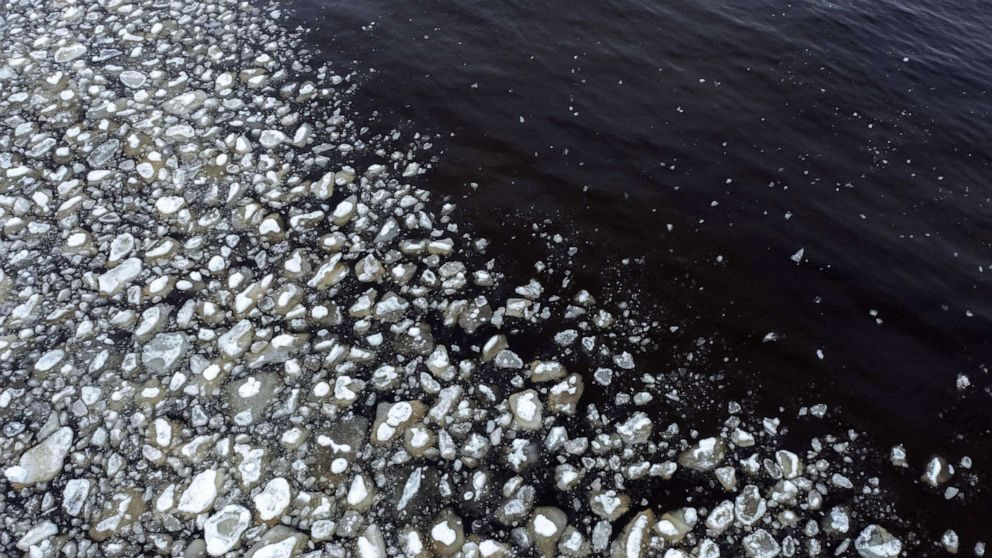
Scientists have gathered further evidence that ocean waters are continuing to warm along with the rest of the planet.
Ocean temperatures reached record-breaking highs for the month of May, the National Oceanic and Atmospheric Administration announced during its monthly climate call on Thursday. Four main factors are contributing to such historic warming of global sea surface temperatures: human-induced climate change, a developing El Nino event, effects from the 2022 Hunga Tonga-Hunga Ha’apai volcano eruption and a new shipping emissions policy aimed at reducing air pollution, said Daniel Swain, a climate scientist at the University of California, Los Angeles.
Some regions are experiencing temperatures up to 7 degrees higher than average for this time of year. In Cabo Verde Island, where hurricanes typically form, the water is typically 75 degrees Fahrenheit (华氏度) but is currently measuring at 82.4 degrees. Combined, land and ocean temperatures in May were the third warmest on record, with surface temperatures increasing about 0.97 degrees Celsius (摄氏度), or 1.75 degrees Fahrenheit, above the 20th century average, Rocky Bilotta, climatologist for the NOAA National Centers for Environmental Information, told reporters. Temperatures were above average throughout most of North America, South America and Africa. Parts of Western Europe, Northwestern Russia, Southeast Asia and the Arctic also experienced warmer than average temperatures this month, Bilotta said.
2023 is very likely to rank among the 10 warmest years on record, according to the National Centers for Environmental Information statistical analysis that was released in April. Should warmer ocean and air surface temperatures continue, 2023 could become the warmest year on record.
Scientists anticipate that the current high temperatures could increase in the coming weeks and set record-shattering numbers, which could spell disaster for coastal communities all over the world. Warmer ocean waters can contribute to more powerful tropical storms and impact marine life. In addition, a warmer atmosphere holds more moisture and can increase potential flooding events. Melting sea ice in the Arctic is also causing sea levels to rise, which is gradually destroying coastlines.
本时文内容由奇速英语国际教育研究院原创编写,未经书面授权,禁止复制和任何商业用途,版权所有,侵权必究!(作者投稿及时文阅读定制请联系微信:18980471698)1.What’s the second paragraph mainly about?
A Factors of high land surface temperatures.
B Reasons for high ocean temperatures.
C Elements of high global sea level.
D Causes of the global climate change.
解析:选B。B段落大意题。根据第二段中的“Four main factors are contributing to such historic warming of global sea surface temperatures...”及后文内容可知,该段主要讲了全球海洋表面温度的破纪录高温是由四个主要因素导致的:人为引起的气候变化、发展中的厄尔尼诺现象、2022年洪加汤加-洪加哈派火山喷发和旨在减少空气污染的船舶排放新政策的影响。故选B。
2.What can we know from Para. 3?
A The water in Cabo Verde Island is 75 ℉ this year.
B Land temperature in May is about 0.97 ℉ higher.
C Most parts of Europe’s temperatures are above average.
D Parts of the Arctic experienced hotter weather this month.
解析:选D。D细节理解题。根据第三段最后一句“Parts of Western Europe, Northwestern Russia, Southeast Asia and the Arctic also experienced warmer than average temperatures this month, Bilotta said.”可知,西欧、俄罗斯西北部、东南亚和北极的部分地区5月也经历了比平均水平更高的温度。故选D。
3.On which condition will 2023 become the warmest year on record?
A If the earth’s surface temperature keeps growing.
B If the high temperatures increase in the coming weeks.
C If ocean temperatures continue to rise.
D If the air temperature declines from now on.
解析:选C。C细节理解题。根据第四段最后一句“Should warmer ocean and air surface temperatures continue, 2023 could become the warmest year on record.”可知,如果海水和大气的表面温度继续升高,2023年可能会成为有史以来最热的年份。故选C。
4.What might be the possible consequence of continuous high temperatures?
A Smaller tropical storms.
B Less marine life.
C Weaker floods.
D Lower sea levels.
解析:选B。B推理判断题。根据最后一段可知,未来持续的高温天气会使海水温度升高,引发更强烈的热带风暴,影响海洋生物,湿热的空气会增大发生洪水的风险,海平面也会上升。故选B。